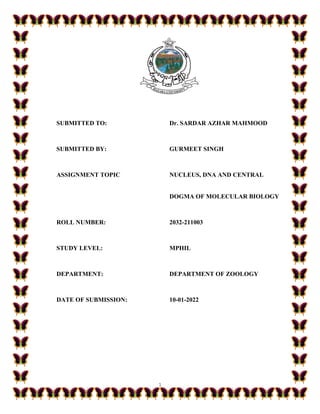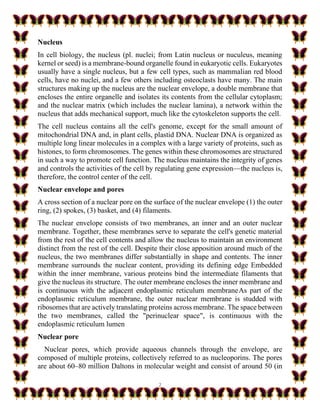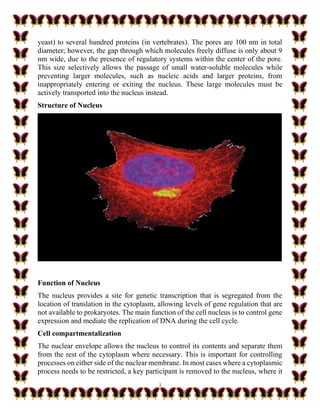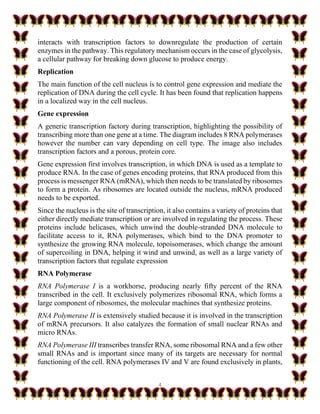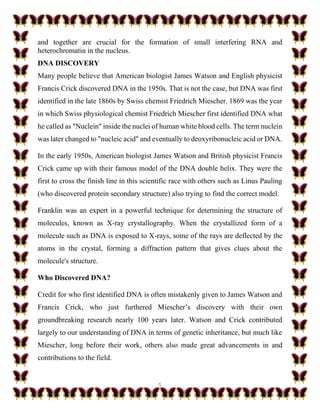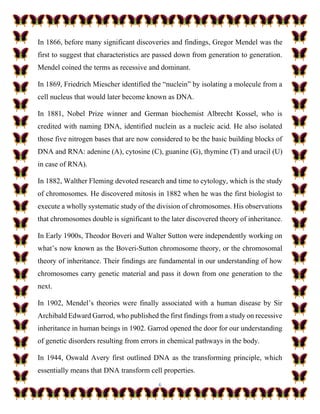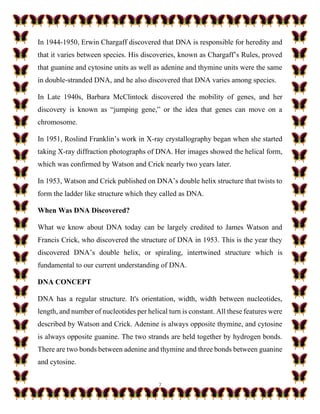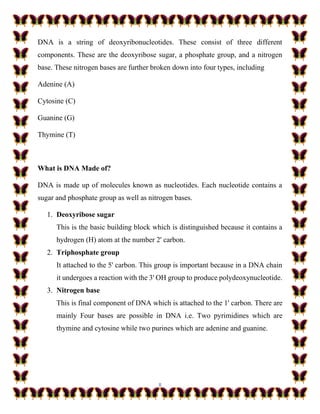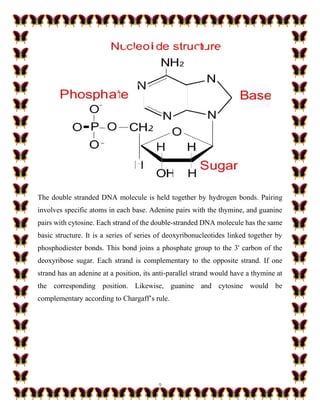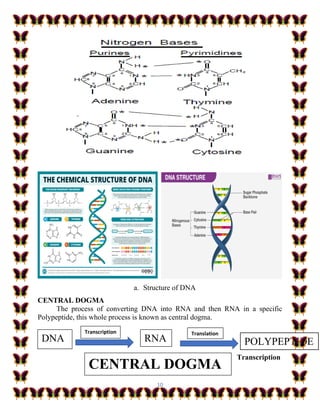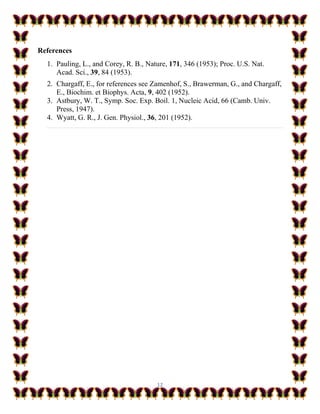DNA and its DISCOVERY.pdf
- 1. 1 SUBMITTED TO: Dr. SARDAR AZHAR MAHMOOD SUBMITTED BY: GURMEET SINGH ASSIGNMENT TOPIC NUCLEUS, DNA AND CENTRAL DOGMA OF MOLECULAR BIOLOGY ROLL NUMBER: 2032-211003 STUDY LEVEL: MPHIL DEPARTMENT: DEPARTMENT OF ZOOLOGY DATE OF SUBMISSION: 10-01-2022
- 2. 2 Nucleus In cell biology, the nucleus (pl. nuclei; from Latin nucleus or nuculeus, meaning kernel or seed) is a membrane-bound organelle found in eukaryotic cells. Eukaryotes usually have a single nucleus, but a few cell types, such as mammalian red blood cells, have no nuclei, and a few others including osteoclasts have many. The main structures making up the nucleus are the nuclear envelope, a double membrane that encloses the entire organelle and isolates its contents from the cellular cytoplasm; and the nuclear matrix (which includes the nuclear lamina), a network within the nucleus that adds mechanical support, much like the cytoskeleton supports the cell. The cell nucleus contains all the cell's genome, except for the small amount of mitochondrial DNA and, in plant cells, plastid DNA. Nuclear DNA is organized as multiple long linear molecules in a complex with a large variety of proteins, such as histones, to form chromosomes. The genes within these chromosomes are structured in such a way to promote cell function. The nucleus maintains the integrity of genes and controls the activities of the cell by regulating gene expression—the nucleus is, therefore, the control center of the cell. Nuclear envelope and pores A cross section of a nuclear pore on the surface of the nuclear envelope (1) the outer ring, (2) spokes, (3) basket, and (4) filaments. The nuclear envelope consists of two membranes, an inner and an outer nuclear membrane. Together, these membranes serve to separate the cell's genetic material from the rest of the cell contents and allow the nucleus to maintain an environment distinct from the rest of the cell. Despite their close apposition around much of the nucleus, the two membranes differ substantially in shape and contents. The inner membrane surrounds the nuclear content, providing its defining edge Embedded within the inner membrane, various proteins bind the intermediate filaments that give the nucleus its structure. The outer membrane encloses the inner membrane and is continuous with the adjacent endoplasmic reticulum membraneAs part of the endoplasmic reticulum membrane, the outer nuclear membrane is studded with ribosomes that are actively translating proteins across membrane. The space between the two membranes, called the "perinuclear space", is continuous with the endoplasmic reticulum lumen Nuclear pore Nuclear pores, which provide aqueous channels through the envelope, are composed of multiple proteins, collectively referred to as nucleoporins. The pores are about 60–80 million Daltons in molecular weight and consist of around 50 (in
- 3. 3 yeast) to several hundred proteins (in vertebrates). The pores are 100 nm in total diameter; however, the gap through which molecules freely diffuse is only about 9 nm wide, due to the presence of regulatory systems within the center of the pore. This size selectively allows the passage of small water-soluble molecules while preventing larger molecules, such as nucleic acids and larger proteins, from inappropriately entering or exiting the nucleus. These large molecules must be actively transported into the nucleus instead. Structure of Nucleus Function of Nucleus The nucleus provides a site for genetic transcription that is segregated from the location of translation in the cytoplasm, allowing levels of gene regulation that are not available to prokaryotes. The main function of the cell nucleus is to control gene expression and mediate the replication of DNA during the cell cycle. Cell compartmentalization The nuclear envelope allows the nucleus to control its contents and separate them from the rest of the cytoplasm where necessary. This is important for controlling processes on either side of the nuclear membrane. In most cases where a cytoplasmic process needs to be restricted, a key participant is removed to the nucleus, where it
- 4. 4 interacts with transcription factors to downregulate the production of certain enzymes in the pathway. This regulatory mechanism occurs in the case of glycolysis, a cellular pathway for breaking down glucose to produce energy. Replication The main function of the cell nucleus is to control gene expression and mediate the replication of DNA during the cell cycle. It has been found that replication happens in a localized way in the cell nucleus. Gene expression A generic transcription factory during transcription, highlighting the possibility of transcribing more than one gene at a time. The diagram includes 8 RNA polymerases however the number can vary depending on cell type. The image also includes transcription factors and a porous, protein core. Gene expression first involves transcription, in which DNA is used as a template to produce RNA. In the case of genes encoding proteins, that RNA produced from this process is messenger RNA (mRNA), which then needs to be translated by ribosomes to form a protein. As ribosomes are located outside the nucleus, mRNA produced needs to be exported. Since the nucleus is the site of transcription, it also contains a variety of proteins that either directly mediate transcription or are involved in regulating the process. These proteins include helicases, which unwind the double-stranded DNA molecule to facilitate access to it, RNA polymerases, which bind to the DNA promoter to synthesize the growing RNA molecule, topoisomerases, which change the amount of supercoiling in DNA, helping it wind and unwind, as well as a large variety of transcription factors that regulate expression RNA Polymerase RNA Polymerase I is a workhorse, producing nearly fifty percent of the RNA transcribed in the cell. It exclusively polymerizes ribosomal RNA, which forms a large component of ribosomes, the molecular machines that synthesize proteins. RNA Polymerase II is extensively studied because it is involved in the transcription of mRNA precursors. It also catalyzes the formation of small nuclear RNAs and micro RNAs. RNA Polymerase III transcribes transfer RNA, some ribosomal RNA and a few other small RNAs and is important since many of its targets are necessary for normal functioning of the cell. RNA polymerases IV and V are found exclusively in plants,
- 5. 5 and together are crucial for the formation of small interfering RNA and heterochromatin in the nucleus. DNA DISCOVERY Many people believe that American biologist James Watson and English physicist Francis Crick discovered DNA in the 1950s. That is not the case, but DNA was first identified in the late 1860s by Swiss chemist Friedrich Miescher. 1869 was the year in which Swiss physiological chemist Friedrich Miescher first identified DNA what he called as "Nuclein" inside the nuclei of human white blood cells. The term nuclein was later changed to "nucleic acid" and eventually to deoxyribonucleic acid or DNA. In the early 1950s, American biologist James Watson and British physicist Francis Crick came up with their famous model of the DNA double helix. They were the first to cross the finish line in this scientific race with others such as Linus Pauling (who discovered protein secondary structure) also trying to find the correct model. Franklin was an expert in a powerful technique for determining the structure of molecules, known as X-ray crystallography. When the crystallized form of a molecule such as DNA is exposed to X-rays, some of the rays are deflected by the atoms in the crystal, forming a diffraction pattern that gives clues about the molecule's structure. Who Discovered DNA? Credit for who first identified DNA is often mistakenly given to James Watson and Francis Crick, who just furthered Miescher’s discovery with their own groundbreaking research nearly 100 years later. Watson and Crick contributed largely to our understanding of DNA in terms of genetic inheritance, but much like Miescher, long before their work, others also made great advancements in and contributions to the field.
- 6. 6 In 1866, before many significant discoveries and findings, Gregor Mendel was the first to suggest that characteristics are passed down from generation to generation. Mendel coined the terms as recessive and dominant. In 1869, Friedrich Miescher identified the “nuclein” by isolating a molecule from a cell nucleus that would later become known as DNA. In 1881, Nobel Prize winner and German biochemist Albrecht Kossel, who is credited with naming DNA, identified nuclein as a nucleic acid. He also isolated those five nitrogen bases that are now considered to be the basic building blocks of DNA and RNA: adenine (A), cytosine (C), guanine (G), thymine (T) and uracil (U) in case of RNA). In 1882, Walther Fleming devoted research and time to cytology, which is the study of chromosomes. He discovered mitosis in 1882 when he was the first biologist to execute a wholly systematic study of the division of chromosomes. His observations that chromosomes double is significant to the later discovered theory of inheritance. In Early 1900s, Theodor Boveri and Walter Sutton were independently working on what’s now known as the Boveri-Sutton chromosome theory, or the chromosomal theory of inheritance. Their findings are fundamental in our understanding of how chromosomes carry genetic material and pass it down from one generation to the next. In 1902, Mendel’s theories were finally associated with a human disease by Sir Archibald Edward Garrod, who published the first findings from a study on recessive inheritance in human beings in 1902. Garrod opened the door for our understanding of genetic disorders resulting from errors in chemical pathways in the body. In 1944, Oswald Avery first outlined DNA as the transforming principle, which essentially means that DNA transform cell properties.
- 7. 7 In 1944-1950, Erwin Chargaff discovered that DNA is responsible for heredity and that it varies between species. His discoveries, known as Chargaff’s Rules, proved that guanine and cytosine units as well as adenine and thymine units were the same in double-stranded DNA, and he also discovered that DNA varies among species. In Late 1940s, Barbara McClintock discovered the mobility of genes, and her discovery is known as “jumping gene,” or the idea that genes can move on a chromosome. In 1951, Roslind Franklin’s work in X-ray crystallography began when she started taking X-ray diffraction photographs of DNA. Her images showed the helical form, which was confirmed by Watson and Crick nearly two years later. In 1953, Watson and Crick published on DNA’s double helix structure that twists to form the ladder like structure which they called as DNA. When Was DNA Discovered? What we know about DNA today can be largely credited to James Watson and Francis Crick, who discovered the structure of DNA in 1953. This is the year they discovered DNA’s double helix, or spiraling, intertwined structure which is fundamental to our current understanding of DNA. DNA CONCEPT DNA has a regular structure. It's orientation, width, width between nucleotides, length, and number of nucleotides per helical turn is constant. All these features were described by Watson and Crick. Adenine is always opposite thymine, and cytosine is always opposite guanine. The two strands are held together by hydrogen bonds. There are two bonds between adenine and thymine and three bonds between guanine and cytosine.
- 8. 8 DNA is a string of deoxyribonucleotides. These consist of three different components. These are the deoxyribose sugar, a phosphate group, and a nitrogen base. These nitrogen bases are further broken down into four types, including Adenine (A) Cytosine (C) Guanine (G) Thymine (T) What is DNA Made of? DNA is made up of molecules known as nucleotides. Each nucleotide contains a sugar and phosphate group as well as nitrogen bases. 1. Deoxyribose sugar This is the basic building block which is distinguished because it contains a hydrogen (H) atom at the number 2' carbon. 2. Triphosphate group It attached to the 5' carbon. This group is important because in a DNA chain it undergoes a reaction with the 3' OH group to produce polydeoxynucleotide. 3. Nitrogen base This is final component of DNA which is attached to the 1' carbon. There are mainly Four bases are possible in DNA i.e. Two pyrimidines which are thymine and cytosine while two purines which are adenine and guanine.
- 9. 9 The double stranded DNA molecule is held together by hydrogen bonds. Pairing involves specific atoms in each base. Adenine pairs with the thymine, and guanine pairs with cytosine. Each strand of the double-stranded DNA molecule has the same basic structure. It is a series of series of deoxyribonucleotides linked together by phosphodiester bonds. This bond joins a phosphate group to the 3' carbon of the deoxyribose sugar. Each strand is complementary to the opposite strand. If one strand has an adenine at a position, its anti-parallel strand would have a thymine at the corresponding position. Likewise, guanine and cytosine would be complementary according to Chargaff’s rule.
- 10. 10 a. Structure of DNA CENTRAL DOGMA The process of converting DNA into RNA and then RNA in a specific Polypeptide, this whole process is known as central dogma. Transcription DNA RNA POLYPEPTIDE Transcription Translation CENTRAL DOGMA
- 11. 11 Transcription is the process of making an RNA copy of a gene sequence. It takes place in cell nucleus. ✓ This copy is called a messenger RNA (mRNA) molecule, leaves the cell nucleus, and enters the cytoplasm. ✓ It directs the synthesis of the protein in cytoplasm which it encodes. Translation The process of translating the sequence of a messenger RNA (mRNA) molecule to a sequence of amino acids during protein synthesis. It takes place in the cytoplasm of the cell. ➢ Genetic code describes the relationship between the sequence of base pairs in a gene and the corresponding amino acid sequence that it encodes. ➢ In the cell cytoplasm, the ribosome reads the sequence of the mRNA in groups of three bases to assemble the protein.
- 12. 12 References 1. Pauling, L., and Corey, R. B., Nature, 171, 346 (1953); Proc. U.S. Nat. Acad. Sci., 39, 84 (1953). 2. Chargaff, E., for references see Zamenhof, S., Brawerman, G., and Chargaff, E., Biochim. et Biophys. Acta, 9, 402 (1952). 3. Astbury, W. T., Symp. Soc. Exp. Boil. 1, Nucleic Acid, 66 (Camb. Univ. Press, 1947). 4. Wyatt, G. R., J. Gen. Physiol., 36, 201 (1952).
